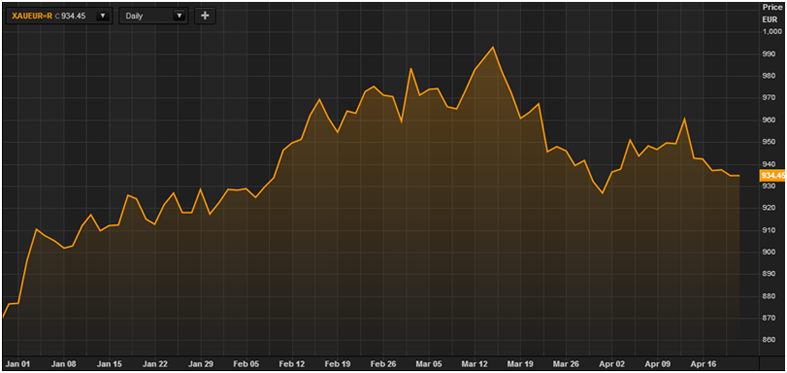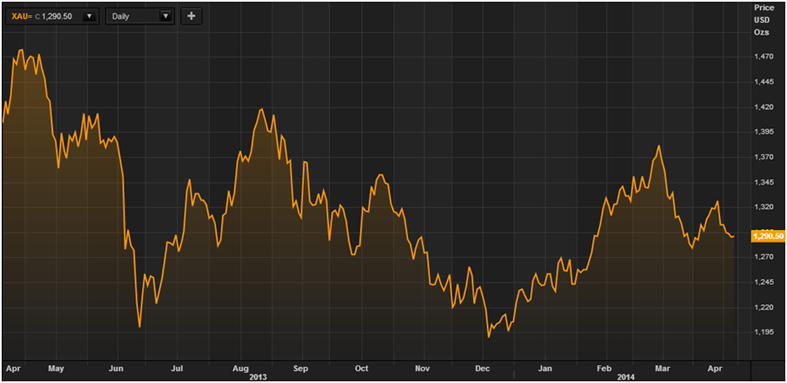by
GoldCore
Today’s AM fix was USD 1,290.75, EUR 935.19
and GBP 767.34 per ounce.
April 17th’s AM fix was USD 1,299.25, EUR 937.48 and GBP 771.89 per ounce.
April 17th’s AM fix was USD 1,299.25, EUR 937.48 and GBP 771.89 per ounce.
Gold fell $4.90 or 0.38% yesterday to
$1,290.00/oz. Silver slipped $0.21 or 1.07% yesterday to $19.42/oz.
Gold recovered from early losses on Tuesday as
the dollar gave back some gains, but sentiment among investors
continued to be lukewarm despite the uncertain backdrop.
Platinum and palladium have risen and recovered
from falls yesterday with platinum trading at $1,411.30/oz and
palladium at $784.60/oz..
Yesterday, gold declined to $1,281.40 the day
before – its lowest since April 3. The dollar index climbed
to a fresh two-week high early on today but later slipped.
Geopolitical tensions over Ukraine has yet to
lift gold’s safe-haven appeal. An international agreement to avert
wider conflict in Ukraine appears to be faltering which should
support gold.
Pro-Moscow separatists show no sign of
surrendering government buildings they have seized. U.S. and European
officials say they will hold Russia responsible and will impose new
economic sanctions if the separatists do not clear out of government
buildings they have occupied across swathes of eastern Ukraine over
the past two weeks.
Thus, the real risk of the toxic combination of
economic, financial and currency wars loom large.
Chinese
Banks And 100,000 Dealers Selling Gold - Demand To Surge
Another 25%
Bloomberg Television’s “On The Move Asia” had a fascinating interview with Albert Cheng, the World Gold Council’s Managing Director, Far East. He discussed China’s gold market and what’s driving the country’s demand with Rishaad Salamat.
Bloomberg Television’s “On The Move Asia” had a fascinating interview with Albert Cheng, the World Gold Council’s Managing Director, Far East. He discussed China’s gold market and what’s driving the country’s demand with Rishaad Salamat.
Since 2003, we have pointed out how China’s
liberalization of its gold market would have enormous ramifications
for the global gold market in terms of a huge new source of demand
and would ultimately lead to higher prices in the long term.
Bloomberg interviewed Goldcore nearly two years
ago in May 2012, about the huge growth in demand in Asia and
particularly China, and we commented that this Chinese demand
was a ‘paradigm shift’: “We could be witnessing a paradigm
shift from China on bullion demand.”
We
pointed out “that the gold market was liberalised in China in 2003
and prior to that gold ownership was banned in China by Chairman
Mao. The per capita consumption of 1.3 billion Chinese
consumers, investors and central bank demand are very significant.”
Please click
here to listen to the interview on the paradigm shift that
is Chinese gold demand.
Albert Cheng reaffirms the paradigm shift for
the gold market that is Chinese gold demand. He points out two very
important facts hitherto not known by market participants.
First, there are now over 100,000 gold bullion dealers selling
coins and bars in China. Second, he says this suggests that the
majority of banks are now offering gold bullion products over the
counter.
The interview is very interesting and is well
worth a look.
Albert
Cheng: China
became the number one [gold] consumption country last year and people
are starting to ask, would this be sustained? The World Gold Council
report] shows that in the next four years, [Chinese gold demand] is
going to increase by another 25 per cent. And the reason for that is
that more and more middle class is coming on stream and people have
money to spend.
Rishaad
Salamat: But
that’s just the thing, more and more people are buying gold, but
what’s caused that change? You can say people have got wealthier
but we saw China overtaking India where there’s been a traditional
demand for gold. That’s not something that is traditional in China,
is it? So what’s driving things?
AC:
I think that the key of this is investment demand. Six years ago you
didn’t see any investment demand in China. China opened up the
investment market through banks and now literally any Chinese person
can walk into a bank and buy gold products. And you look at the
number of outlets where people can buy investment gold, gold bars,
gold coins – there are a hundred thousand of them in China. If I
make a comparison with America — Starbucks, McDonald’s and Subway
together have only fifty thousand outlets. In China there are more
than a hundred thousand outlets where you can buy gold. So, the
availability of gold in China, in every city, is the main driver
behind gold.
AC: Wedding
jewellery consumption accounts for 40 per cent of jewellery
consumption in China; there is about 300 tons of gold sold in
jewellery form.
AC: When
people buy 24-carat gold jewellery, which has a markup of less than
10 per cent if it’s a popular item, 15 – 20 per cent if it’s a
more designer item, that is the reason why Chinese people buying gold
jewellery in China is equivalent to buying a piece of metal. At the
end of the day, this is a way for them to keep their money, to keep
their wealth. If they want to sell it, there is always a resale price
for this kind of pure gold metal.
So why China has become number one in the world
is because if [people] want to save money China, there is not much
alternative for them — you either can buy property of you get into
the stock market. But neither of those are very attractive at the
moment to the Chinese investor. In the past few years we’ve seen
more and more people buying gold jewellery as well as gold bars.
RS: You’ve
got this forecast in that we’ve been talking about where there’s
a 25% gain in gold demand from China over the next four years. What
are the risks here to this to the downside?
AC: We
all know that China is undergoing a big economic transition from an
export-driven economy to a domestic consumption economy. This year is
a transitional year. With these changes there will be a lot of major
disruptions to the economic life of people here, and again, the
shadow banking issue, which the government has addressed, will have
an effect on liquidity and it also may impact gold in the short term.
Long term, if China gets on to a domestic consumption economy, it
will be good for gold jewellery consumption. More and more people
will be encouraged to move from rural areas into cities, the
urbanisation process will continue and people who are getting rich
will get into consumption of gold jewellery or buying gold bars. So
short term we will see some headwind but long term, medium term, we
see the gold market continue to grow.
The
interview can be watched here.


No comments:
Post a Comment